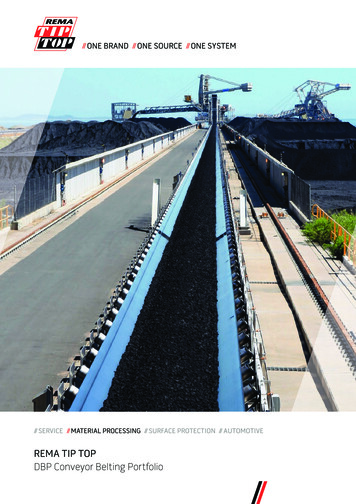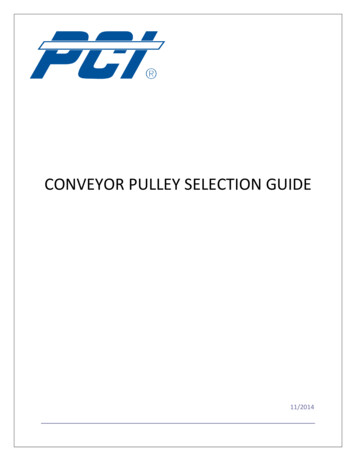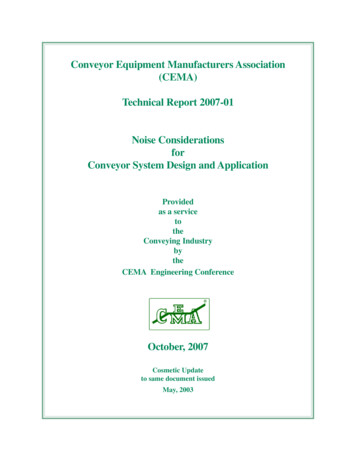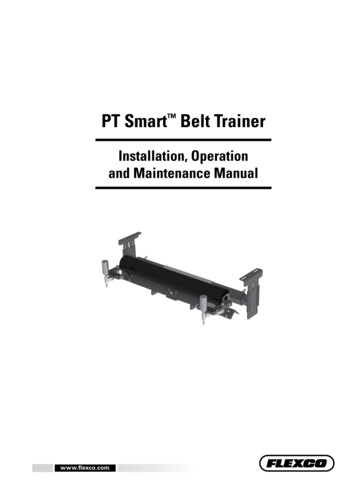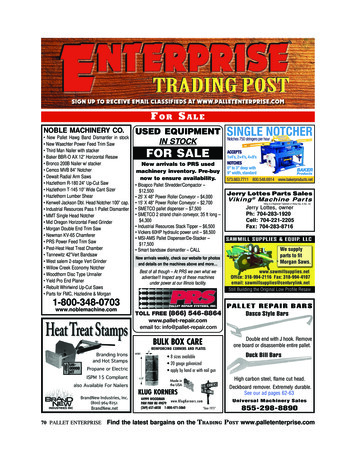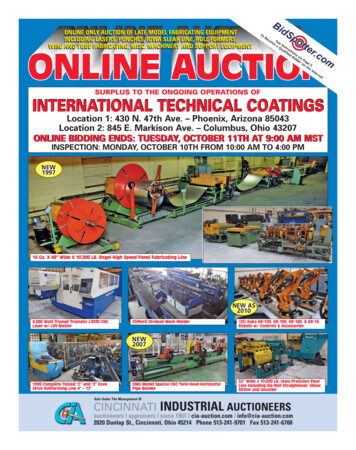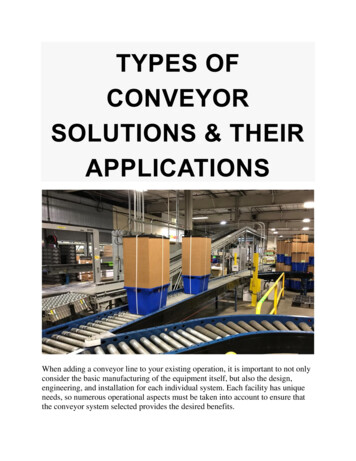
Transcription
TYPES OFCONVEYORSOLUTIONS & THEIRAPPLICATIONSWhen adding a conveyor line to your existing operation, it is important to not onlyconsider the basic manufacturing of the equipment itself, but also the design,engineering, and installation for each individual system. Each facility has uniqueneeds, so numerous operational aspects must be taken into account to ensure thatthe conveyor system selected provides the desired benefits.
Factors that must be taken into account include: Materials the system handlesOperation environmentSpace and configurationAccess requirements for equipment and personnelSpeed and throughput volumeRequired maintenanceLevel of automationTypes of Industrial Conveyor SystemsAlthough some conveyor systems are used for simple, individual tasks, industrialconveyor systems typically include various functions and are integrated to performmore complex operations. Conveyors have dozens of classifications and have beenengineered into a wide variety of configurations. Below is a short overview of afew common types of conveyors, their uses, and their benefits.Belt ConveyorsTypically the first term that comes to mind when someone thinks of the word“conveyor” is “conveyor belt.” Also one of the most common types of conveyors,
belt conveyors are simple - and low cost - in their methodology of movingproducts from point A to point B. Construction of belt conveyors differs, butgenerally, all are composed of modular plastic or continuous flexible belts whichare operated through the use of pulleys or sprockets. They are effective in movingan assortment of product shapes, sizes, and weights while maintaining full control.Belt conveyors can be customized into various layouts including inclines/declinesand curves, and are used within countless production lines, warehouses, fulfillmentcenters, various sortation systems, and even applications that require moving bulkmaterials.Roller ConveyorsRoller conveyors move items and materials using parallel-mounted rollers whichfacilitate smooth movement. They can be designed in a number of differentvariations. The most basic format is gravity roller, where the rollers are nonpowered and the products travel along them freely. When mounted on a slightdecline, the product will use gravity to provide the motive force in that direction.Additionally, skatewheel gravity conveyors operate the same way but instead ofrollers, a series of narrow skatewheels are mounted and “roll” more easily,allowing for use with lighter packages.
Chain driven live roller (CDLR) is another design and uses a combination ofrollers with sprockets linked with a chain. This type is commonly used forhandling heavy products with flat bottoms, or pallets. CDLR conveyors areadvantageous for their powered control, and ability to withstand harsh operatingconditions. Options can allow for the accumulation of products- where the linecontinues to run, but the products will line up in the queue on the conveyor. As aworkhorse in the industry, this type of conveyor is often used for delivery systemsin assembly lines, packaging facilities, food processing applications, and plentymore.Motorized Roller ConveyorsOne of the most recent designs of the roller conveyor system answers the question:instead of one motor running all rollers together, what if a small motor is put insidethe roller? Each one of these motorized rollers would power its own section ofrollers - or even a short belt - via drive bands, creating individual “zones.” Variouslevels of control are available to suit the requirements. Photo-eye sensors triggerthe motorized roller when the space is clear, prompting products to move fromzone to zone for zero-pressure accumulation. This sophisticated type of conveyoruses low voltage power which can result in plug and play installation. This designis particularly useful in warehousing, distribution, and variousassembly/manufacturing applications, and allows for smoother, more precisemovement of products along the line without contact.Chain ConveyorsChain conveyor systems use chains and sprockets with appropriate frames anddrives for rugged construction. They include floor mounted and overhead typesand come in a broad range of designs to meet the needs of a variety of applications.Floor mounted conveyors are typically employed in applications that require themovement of heavy objects including pallets, gaylords, and drums. Many styles ofright-angle transfers also utilize this design. They are found in assembly &packaging lines, and in a wide array of industries such as pharmaceutical,cosmetics, and consumer goods. In warehousing, distribution, and manufacturingprojects, an overhead continuous chain conveyor can be utilized for transport orreturns of products, parts, packaging materials, and containers when floor space isat a premium.
Vertical ConveyorsCombining a few styles of conveyors into a final category, vertical conveyors are acatch-all to describe systems that raise or lower products from one area to anotherat a different elevation or on a different floor. Spiral conveyors are a common type,which use a special belt or chain in a rotary vertical motion to change elevation forproducts while taking up less floor space than an incline. Vertical lift conveyorsare another type and are categorized into either reciprocating or continuous, eachbeing highly versatile. These types of conveyors are found in many applications,including warehouse/distribution centers, pharmaceutical plants, food & beverageprocessing, general manufacturing, and consumer goods production.Integrated Conveyor System Solutions from Precision AutomationThere are several additional types of conveyor systems to review and discuss, butmost of what we deal with fall into one of the groups mentioned above. And ittakes more than a simple categorization to determine the ideal conveyor system fora given project. The particular product being conveyed factors most heavily in theselection process of conveyor type, length, width, speed, and more. However, if a
customer wants something totally unique that does not fit into a general category,our team will design and manufacture a custom system.Since 1946, Precision Automation has been a valued provider of industrialconveyors for numerous industries. Our conveyor systems can be configured tosuit a variety of automation and material handling needs. What sets us apart is ourproven process of understanding each unique project specification, conceptdevelopment, system design, procurement and fabrication of components,assembly, testing, and installation. Our highly experienced team is dedicated toproviding cost-efficient solutions tailored to meet the requirements of particularapplications without the need for outsourcing.To learn more about our integrated conveyor system solutions, contact us today.
more complex operations. Conveyors have dozens of classifications and have been engineered into a wide variety of configurations. Below is a short overview of a few common types of conveyors, their uses, and their benefits. Belt Conveyors Typically the first term that comes to mind when someone thinks of the word "conveyor" is "conveyor .
